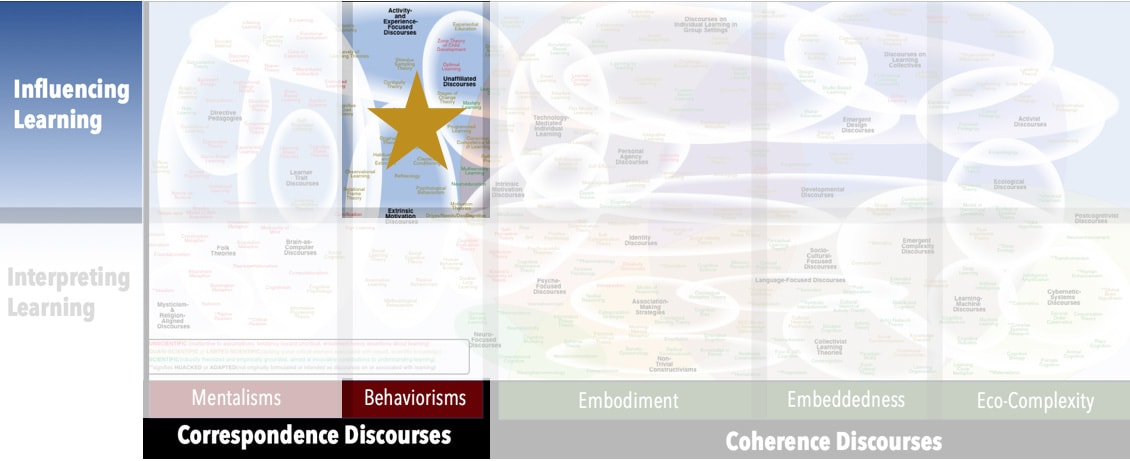AKA
Behavioral Engineering
Behavior Modification Therapy
Focus
Problematic individual behaviorsPrincipal Metaphors
- Knowledge is … repertoire of behaviors
- Knowing is … behaving (triggered by stimuli)
- Learner is … an organism (individual-in-context)
- Learning is … changes in behavior (linking stimuli to responses)
- Teaching is … training; engineering behavior (through deliberate conditioning)
Originated
1970sSynopsis
While subject to various interpretations, Behavior Modification is used more often to refer to the application of behaviorism-based techniques to decrease maladaptive behavior. Typically, Behavior Modification plans follow highly prescriptive and rigidly implemented protocols of rewards and/or punishment. Associated constructs and subdiscourses include:- Classroom Behavior Modification – a version of Behavior Modification that focuses on influencing inappropriate classroom behavior with a focus on responses available to teachers – which include both direct interventions as well as strategic use of seating plans, assignment deadlines, task requirements, and so on. Associated constructs include:
- Contingency Contract – an agreement (usually between a teacher and a student or a group of students) that specifies desired/target/terminal behaviors and the consequences/reinforcers of meeting those behaviors
- Group Contingency – the requirement that everyone in a group by perform a desired/target/terminal behavior in order for the specified consequences/reinforcers to occur
- Cognitive Behavior Modification – using the learner’s thoughts as triggers and/or feedback in Behavior Modification techniques
- Counterconditioning – the process of extinguishing an undesired response to a specific stimulus (e.g., fear triggered by thunder) by reinforcing an incompatible response (e.g., comforted assurance)
- Exposure Therapy (Joseph Wolpe, 1950s) – based on principles of Classical Conditioning, any method for treating anxiety disorders by exposing patients to the trigger of the anxiety without exposing them to any danger. Specific types of Exposure Therapy include:
- Flooding (In Vivo Exposure Therapy) (Thomas Stampfl, 1960s) – a method for treating fears, anxieties, and stress-related disorders by directly engaging with the triggers of negative responses and working to replace them with less traumatic responses
- Systematic Desensitization (Graduated Exposure Therapy) (Joseph Wolpe, 1950s) – a three-component method for treating fears and anxieties. The first two components, engaged separately, are to identify triggers of negative responses and to engage in a relaxation practice. The third component involves gradually linking the triggers to the relaxation practice.
- Virtual Reality Therapy (VRT; Computerized CBT (CCBT); Simulation for Therapy (SfT); Virtual Reality Exposure Therapy (VRET); Virtual Reality Immersion Therapy (VRIT)) (Max North, 1990s) – a type of Exposure Therapy that involves the use of digital simulations and computer-based tasks that are tailored to the condition being addressed
- Reversal Learning – the extent to which one can suppress established patterns of acting, whether those patterns are previously learned or matters of biological disposition
Commentary
With its focus on decreasing a specific behavior, rather than supporting a learner to cope in complex social and cultural worlds, Behavior Modification has been widely criticized as diminishing rather than enabling. In this regard, criticism-focused discourses have arisen around:- Corporal Punishment – includes any act intended to inflict physical pain in response to (and in an attempt to reduce the manifestation of) a specific, undesired behavior. While legal within parent–child relationships almost everywhere, rigorous studies put question to its efficacy and raise the possibility that it can contribute to significant and enduring psychological issues.
- Poisonous Pedagogy (Black Pedagogy) (Katharina Rutchky, 1970s) – a broad category that encompasses all other hurt-intentioned acts aimed at manipulating children’s behaviors – including, for example, Corporal Punishment, isolation, shaming, and mocking. The phrase, Poisonous Pedagogy, signals an emerging sentiment that such acts contribute to dysfunctions.
Authors and/or Prominent Influences
Edward Thorndike; Joseph WolpeStatus as a Theory of Learning
Behavior Modification is not a theory of learning.Status as a Theory of Teaching
Behavior Modification is the application of a theory of learning (i.e., Methodological Behaviorism). It does not seek to offer any insight into the nature or processes of human learning, focusing rather on protocols for suppressing target behaviors.Status as a Scientific Theory
With regard to methodology, research on Behavior Modification meets most of the requirements of a scientific inquiry. However, it falls short on matters of critical attentiveness to its central constructs.Subdiscourses:
- Classroom Behavior Modification
- Cognitive Behavior Modification
- Contingency Contract
- Corporal Punishment
- Counterconditioning
- Exposure Therapy
- Flooding (In Vivo Exposure Therapy)
- Group Contingency
- Poisonous Pedagogy (Black Pedagogy)
- Reversal Learning
- Systematic Desensitization (Graduated Exposure Therapy)
- Virtual Reality Therapy (VRT; Computerized CBT (CCBT); Simulation for Therapy (SfT); Virtual Reality Exposure Therapy (VRET); Virtual Reality Immersion Therapy (VRIT))
Map Location

Please cite this article as:
Davis, B., & Francis, K. (2023). “Behavior Modification” in Discourses on Learning in Education. https://learningdiscourses.com.
⇦ Back to Map
⇦ Back to List
